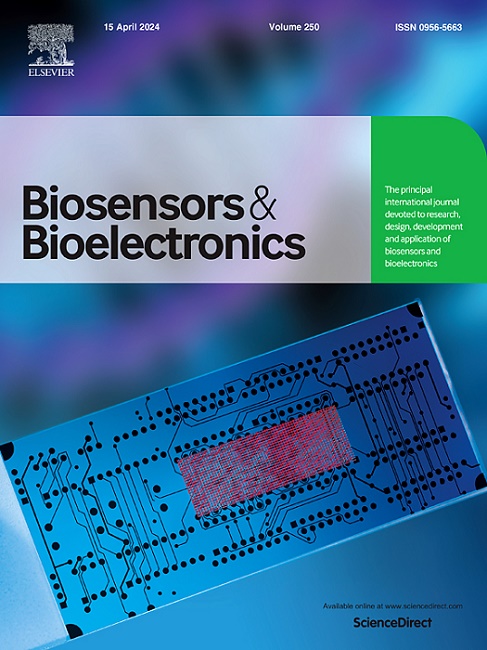使用 ZnO 涂层光纤传感器高灵敏、实时地检测糖尿病丙酮生物标记物。
IF 10.5
1区 生物学
Q1 BIOPHYSICS
引用次数: 0
摘要
这项研究介绍了一种 ZnO 涂层无芯光纤传感器 (OFS),设计用于高灵敏度地检测丙酮蒸气。丙酮是糖尿病的一种关键生物标志物,与血糖水平有关,可通过呼气分析进行无创检测。OFS 采用无芯光纤(NCF)作为传感区域,表面涂有一层薄薄的氧化锌纳米粒子,以增强与光纤界面上的挥发性有机化合物之间的蒸发场相互作用。NCF 段优化为 3.4 厘米,通过多模干扰 (MMI) 使耦合效率最大化。OFS 用六种不同的挥发性有机化合物进行了测试,包括丙酮、甲醇、乙醇、异丙醇、甲苯和二甲苯,浓度范围为 1 至 10 ppm,因为它们是与糖尿病有关的常见挥发性有机化合物。与其他挥发性有机化合物相比,所制造的 OFS 对丙酮(0.116 nm/ppm)具有很高的灵敏度和出色的选择性。它对丙酮的检测限较低,为 3.26 ppm,响应速度快(26 秒),恢复时间长(32 秒),30 天内漂移极小(0.2%)。这种氧化锌涂层无芯 OFS 在室温下运行,提供了一种经济高效且简单的制造方法,显示出在糖尿病中进行无创丙酮监测的巨大潜力。本文章由计算机程序翻译,如有差异,请以英文原文为准。
Highly sensitive and real-time detection of acetone biomarker for diabetes using a ZnO-coated optical fiber sensor
This work presents a ZnO-coated no-core optical fiber sensor (OFS) designed for the highly sensitive detection of acetone vapor. Acetone is a key biomarker for diabetes, which is linked to blood glucose levels and can be detected non-invasively through breath analysis. The OFS utilizes a no-core fiber (NCF) as the sensing region, coated with a thin layer of ZnO nanoparticles to enhance evanescent field interaction with the VOCs at the fiber interface. The NCF segment, optimized to 3.4 cm, maximizes coupling efficiency through multi-mode interference (MMI). The OFS was tested with six different VOCs including acetone, methanol, ethanol, isopropanol, toluene and xylene at concentrations ranging from 1 to 10 ppm, as they are commonly exhaled VOCs associated with diabetes. The fabricated OFS demonstrated high sensitivity to acetone (0.116 nm/ppm) and excellent selectivity compared to other VOCs. It exhibited a lower detection limit of 3.26 ppm, rapid response (26 s), and recovery times (32 s) for acetone, with minimal drift (0.2%) over 30 days. Operated at room temperature, this ZnO-coated no-core OFS offers a cost-effective and simple fabrication approach, showing promising potential for non-invasive acetone monitoring in diabetes.
求助全文
通过发布文献求助,成功后即可免费获取论文全文。
去求助
来源期刊

Biosensors and Bioelectronics
工程技术-电化学
CiteScore
20.80
自引率
7.10%
发文量
1006
审稿时长
29 days
期刊介绍:
Biosensors & Bioelectronics, along with its open access companion journal Biosensors & Bioelectronics: X, is the leading international publication in the field of biosensors and bioelectronics. It covers research, design, development, and application of biosensors, which are analytical devices incorporating biological materials with physicochemical transducers. These devices, including sensors, DNA chips, electronic noses, and lab-on-a-chip, produce digital signals proportional to specific analytes. Examples include immunosensors and enzyme-based biosensors, applied in various fields such as medicine, environmental monitoring, and food industry. The journal also focuses on molecular and supramolecular structures for enhancing device performance.
 求助内容:
求助内容: 应助结果提醒方式:
应助结果提醒方式:


